We may receive a commission when you use our affiliate links. However, this does not impact our recommendations.
 This traditional finish from Denmark is simple, safe and tactile.
This traditional finish from Denmark is simple, safe and tactile.
When I tell fellow woodworkers and customers that I use soap as a finish on some of my tables and chairs, they think I’m joking. Then, when I pull out a Mason jar filled with soap finish to show them how it works, they laugh because it looks a lot like, well, snot.
After seeing the results on finished pieces, however, they know it’s no joke.
Using soap as a finish on furniture and floors is common in Denmark and other northern European countries. It produces a low-sheen finish that is remarkably soft to the touch. It looks best on light-colored woods – from white maple to woods about as dark as white oak.
And, as you can imagine, it is a safe finish. It might be the only finish where your hands and clothes are cleaner after using it. It is best used on bare wood or wood that has a soap finish on it already. It doesn’t do much over an existing film finish.
There are downsides to the finish – it’s not durable and requires regular but simple maintenance.
For the last year, I have been experimenting with different recipes for soap finish made using a variety of products you can get through the mail, at health food stores and at your grocery. After finishing, and living with, about a dozen pieces using soap, I am a convert. It might not the best finish for every situation, but if you are curious it is definitely easy to try and master.
The Right Soap
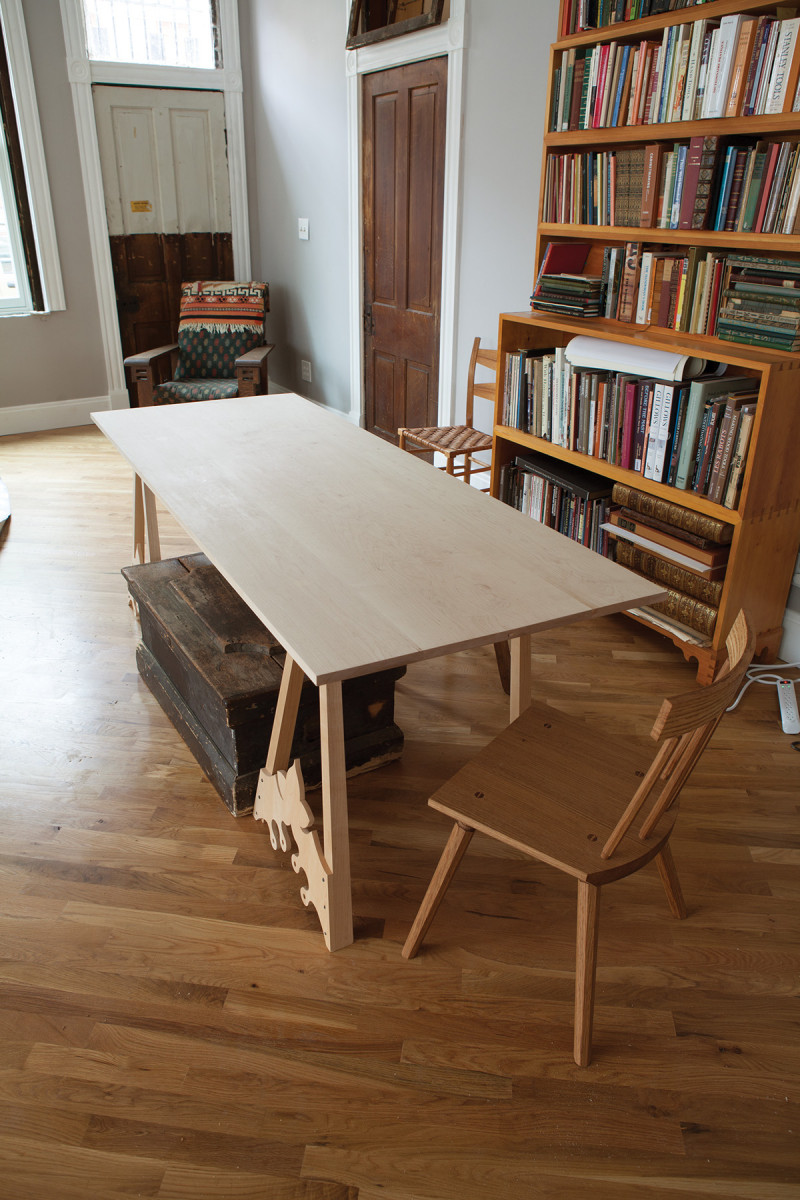
Flat white. This maple tabletop is finished with two coats of soap finish that was mixed to produce a particularly flat sheen.
You can’t just rub a bar of Irish Spring on a chair and call it done. (Wait, maybe you can. Try it for yourself.)
A Danish soap finish uses natural soap flakes that are mixed with hot water. Soap flakes are a pure form of soap that doesn’t include additional detergents, fragrances or other modern chemicals. It is simply an oil that has been mixed with an alkali solution to create a salt of a fatty acid. Our ancestors made soap by pouring tallow (animal fat) onto the ashes from a fire.
You can still buy this important and elemental soap from a variety of sources all over the world. Look for companies that specialize in “natural soap flakes.” You’ll find a bunch. (See below.)
The flakes are white and soft to the touch. They don’t have much of a smell until you mix them with water. Then they will smell just a wee bit. Your nose will register the smell as “clean.”
The other option is to make your own soap flakes from “Castile soap.” Castile soap is a simple soap made from a vegetable oil, such as olive oil. You can find bars of this soap at many health food stores. I can get it from my corner grocery. Shred the Castile soap like you would a hard cheese to make your soap flakes.
If you mix these flakes with hot water you will produce a solution that is somewhere between whipping cream and a soft wax in consistency. The trick is deciding how much water to add to how much soap.
Two Solutions
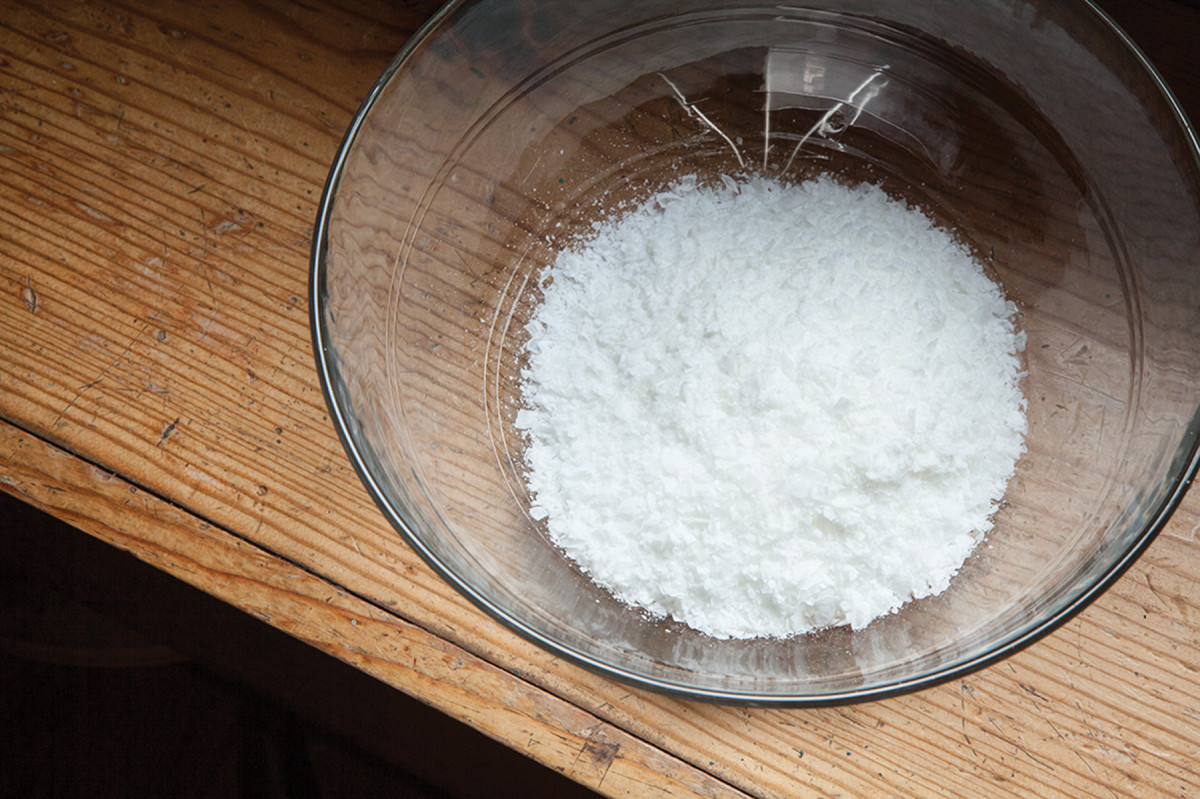
Soap flakes. Simple soap flakes have no detergents or fragrances added – that’s what is best for a soap finish.
When I first started to dig into the recipes for a soap finish, I found two types. One used a lot of water and a little soap – a couple spoonfuls of soap and a liter of water was a typical recipe. Then there were recipes that used equal parts soap and water. I tried both.
When you mix a little soap and a lot of water you make a mayonnaise-like solution that’s easy to apply and imparts a matte finish with mild protection.
When you mix equal parts soap and boiling water you quickly end up with a waxy solution that gives furniture a semi-gloss sheen and mild protection.
Neither soap finish is bullet-, baby- or waterproof. But both are easily applied, repaired and renewed.
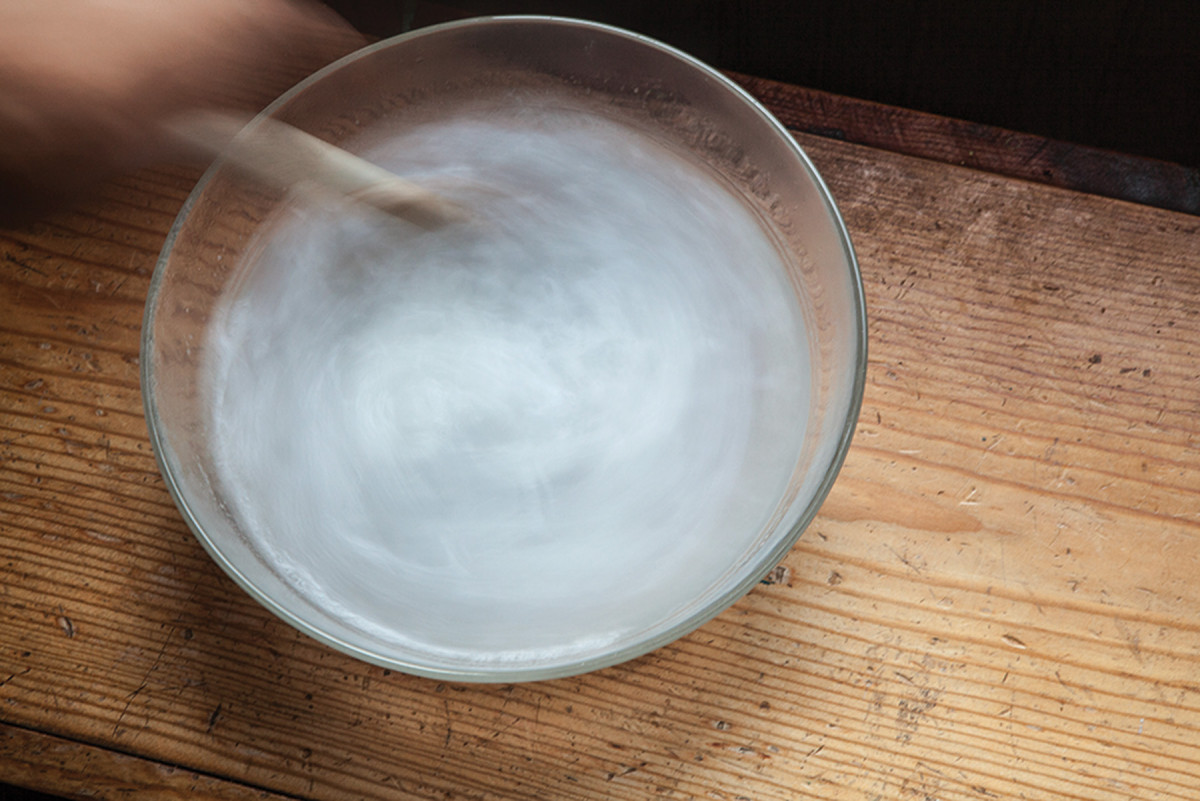
Soap & hot water. A solution of water and a little soap will make a soupy mix that doesn’t look like much at first.
To mix up a watery solution – what I call “soap soup” – boil four cups of water and pour that into one cup of soap flakes. Stir vigorously. The result looks like bathwater after a long soak. Don’t throw it out in frustration (like I did the first time I made it).
Put the solution in a jar to let it cool and set up. After a few hours, the liquid will turn an opaque white and become a bit stiff like shaving cream or mayonnaise. After 24 hours, the stuff is ready to use on furniture.
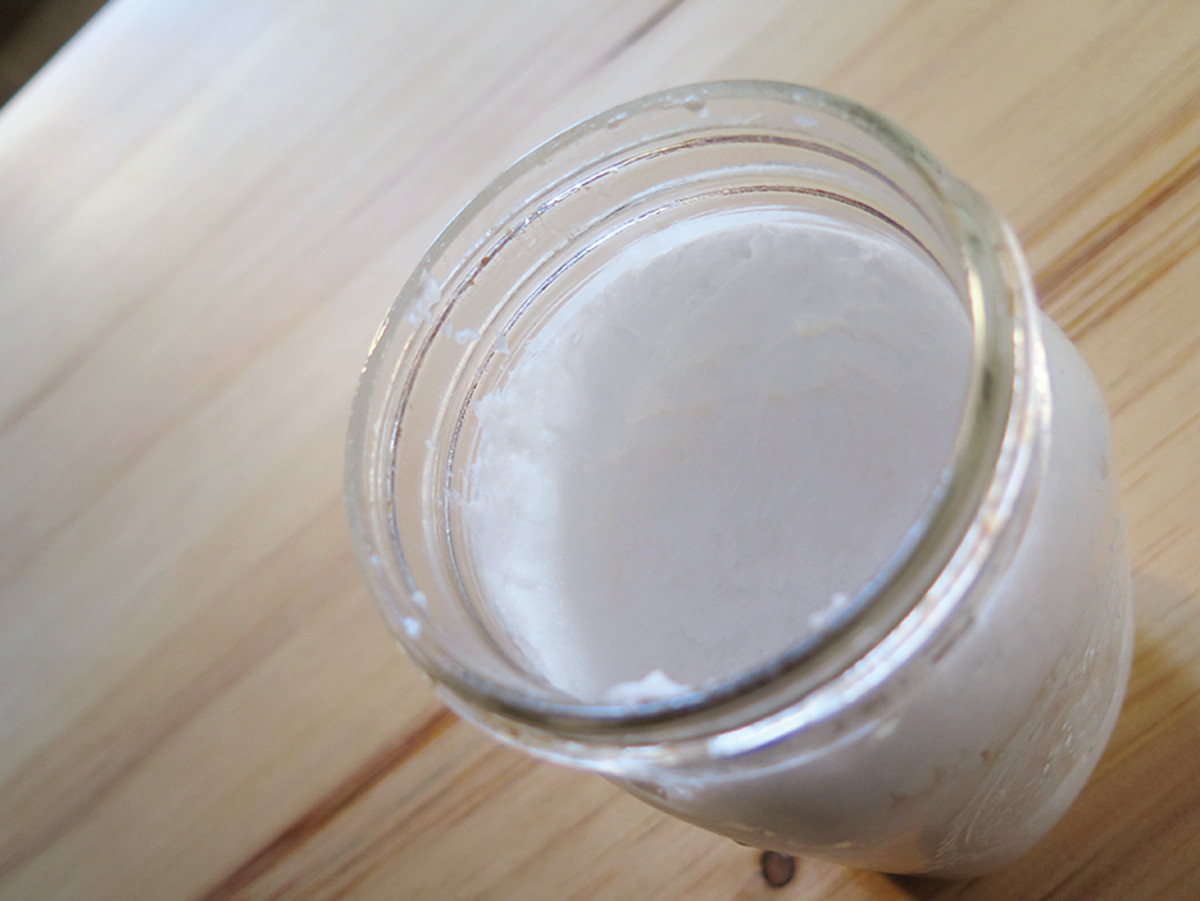
Soap soup (later). After 24 hours the “soup” firms up into something like mayonnaise. This can be easily ragged onto wood.
To mix a hard solution, begin with a cup of boiling water and a cup of soap flakes. Pour about half of the boiling water on the flakes and mix. Add water bit by bit until you get a stiff whipped-cream-like solution. Let that cool and set up. After about an hour, it will be waxy and ready to use.
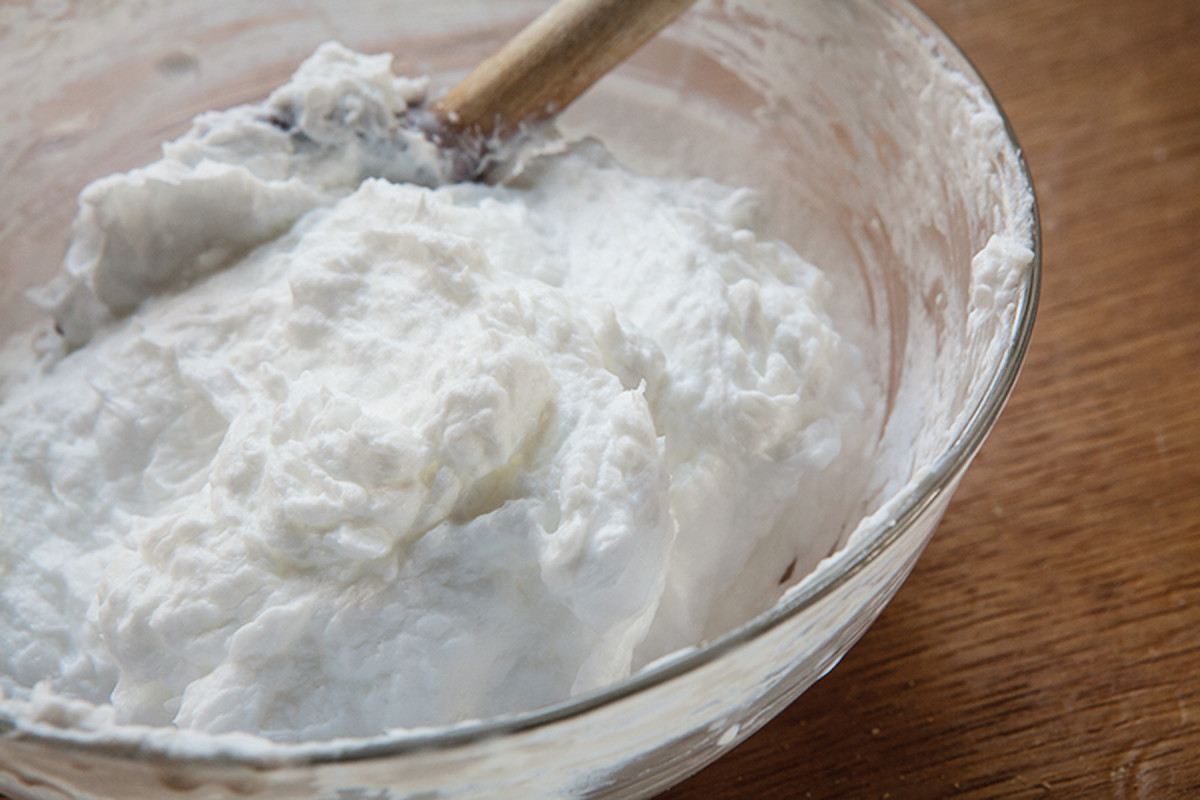
Wax on. With equal parts water and soap, you’ll quickly create a stiff mixture that can be almost immediately applied to the work.
Application
Applying the soap soup is easy. Rag it on so that the wood is wetted and a bit foamy. Let it stand for a couple minutes. Then take a clean rag and wipe off the excess. Let it dry for an hour then sand the surface – I use a #320-grit sanding sponge – and repeat.
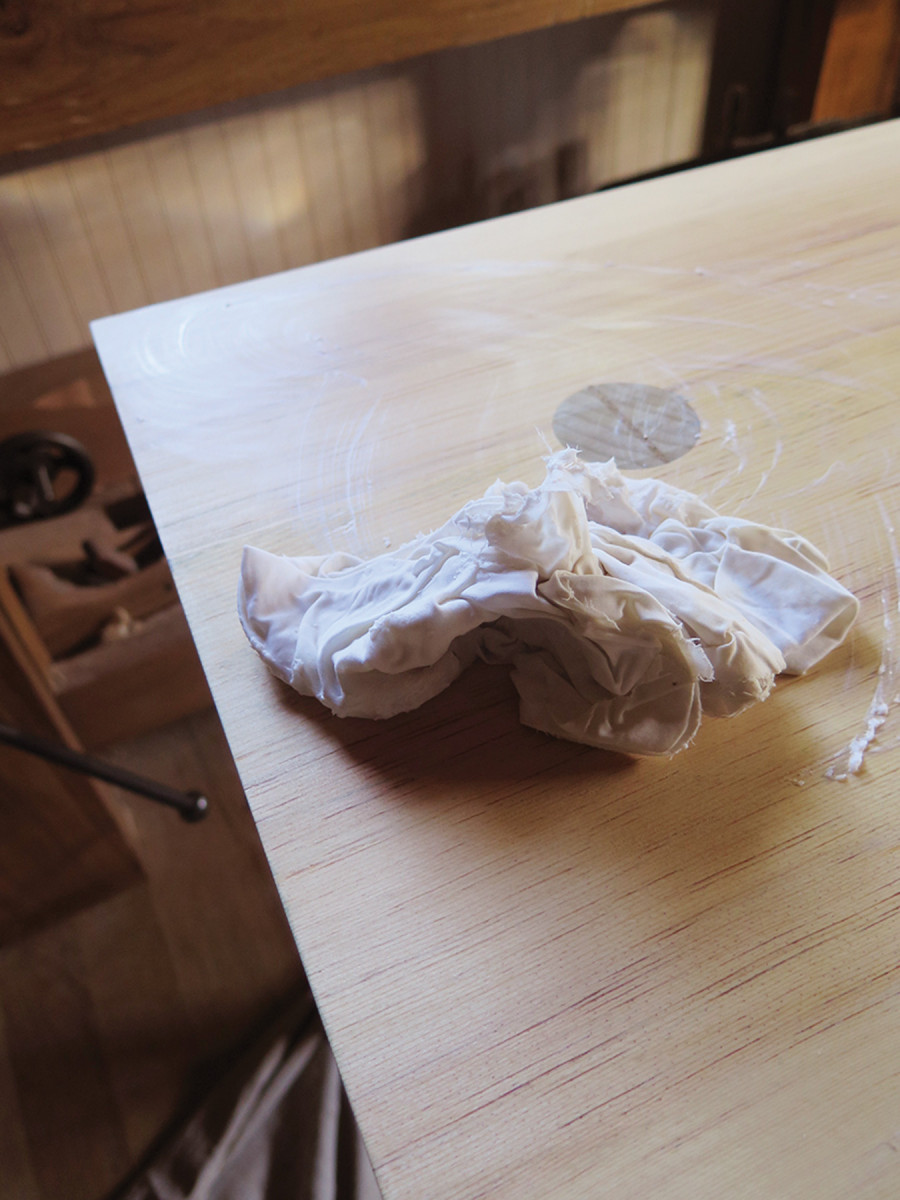
Soap’s on. The thin soap finish rags on like a soft hand cream.
After four coats you will start to see some sheen build up. Stop whenever you like the way it looks. Two coats is reasonable – so is 10.
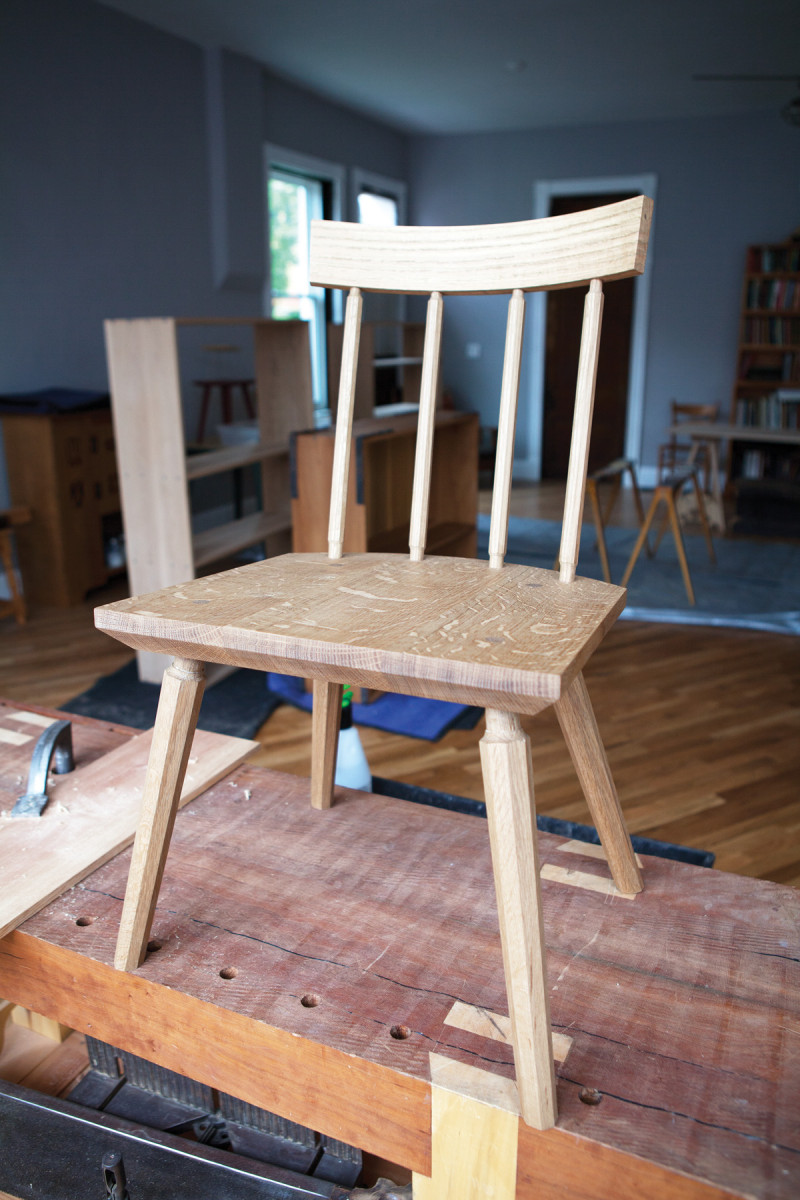
Oak & soap soup. Here’s a white oak chair finished with the “soap soup” solution. It is nearly dead-flat in sheen and takes on a grayish cast from the soap.
To renew the finish, apply more soap solution to clean it and create the original soft sheen. How often you need to apply soap depends on how much you use the piece. I have a soaped worktable that sees daily use and needs a new coat every six months.
The waxy solution is applied more like a wax. Get a clean, cotton cloth and scoop a single dip-sized dollop into the middle. Wrap up the soap and twist the cloth around it to create a ball of rag and soap.
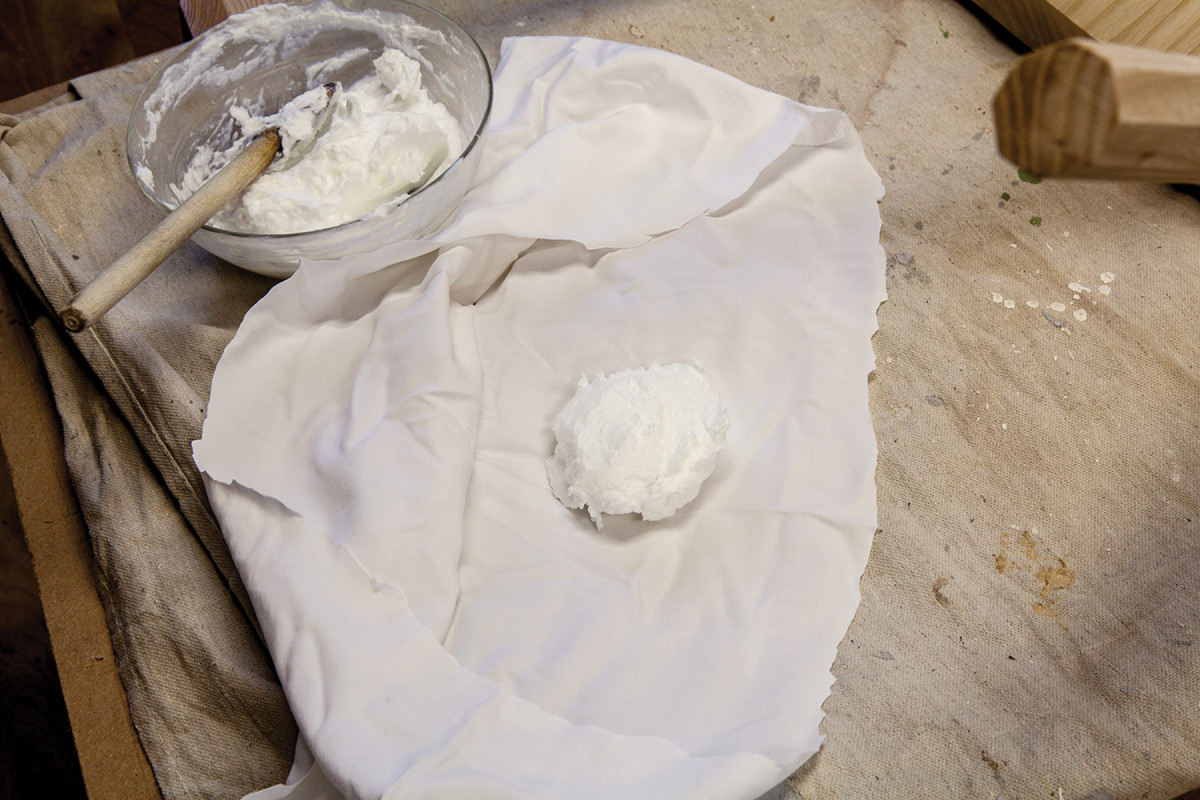
The whole ball of soap. To apply the wax-like mixture, spoon the soap into a rag and wrap it around the ball to create something similar to a “rubber” when French polishing.
Squeeze the rag and the soap will begin to leach out of the rag. Rub the rag on your work and a small amount of the waxy soap will flow onto the wood. After you finish a leg or seat or door of your project, come back with a clean rag and buff out the soap solution. It will polish up to a semigloss sheen like any wax polish.
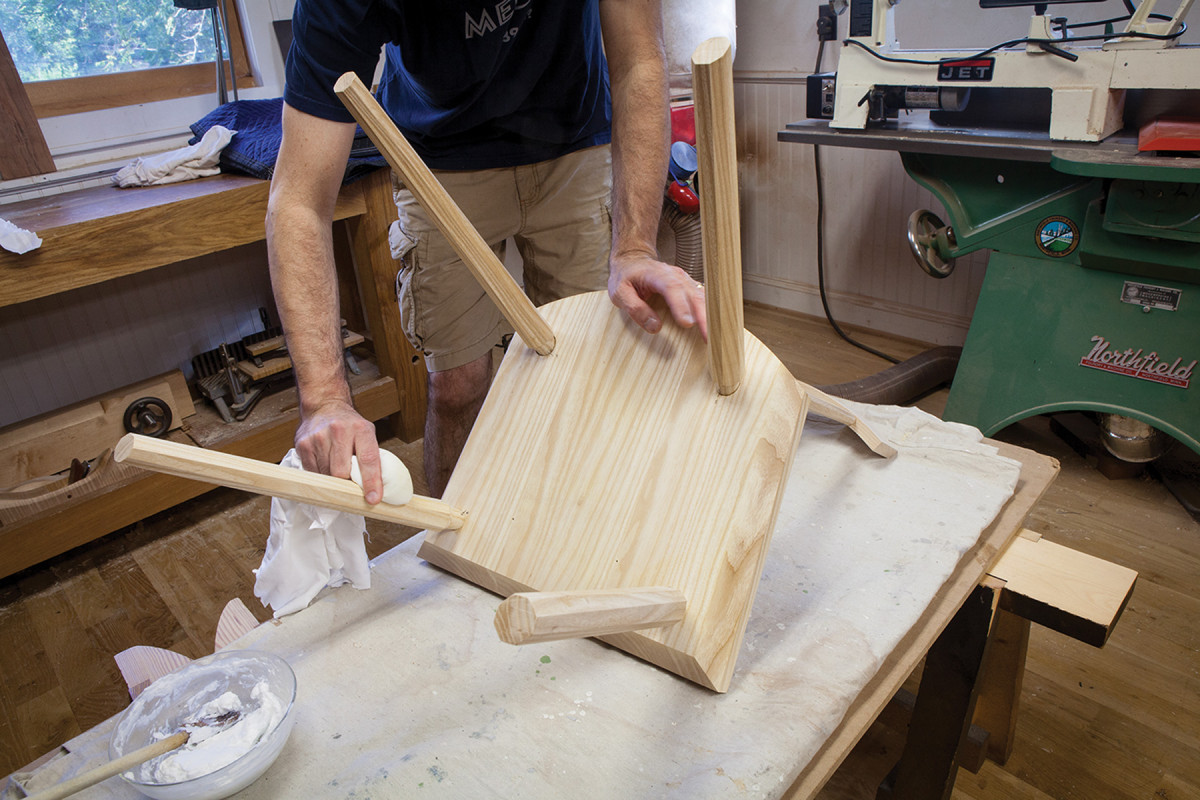
Rub-a-dub-dub. Your body heat and friction will start to melt the soap and it will flow through the rag.
Repeat the process a couple times until you get the look you want.
This soap polish can be renewed at any time. You can use either solution at any point – use the watery solution over the waxy solution if you want to experiment with a flat look. Or vice versa.
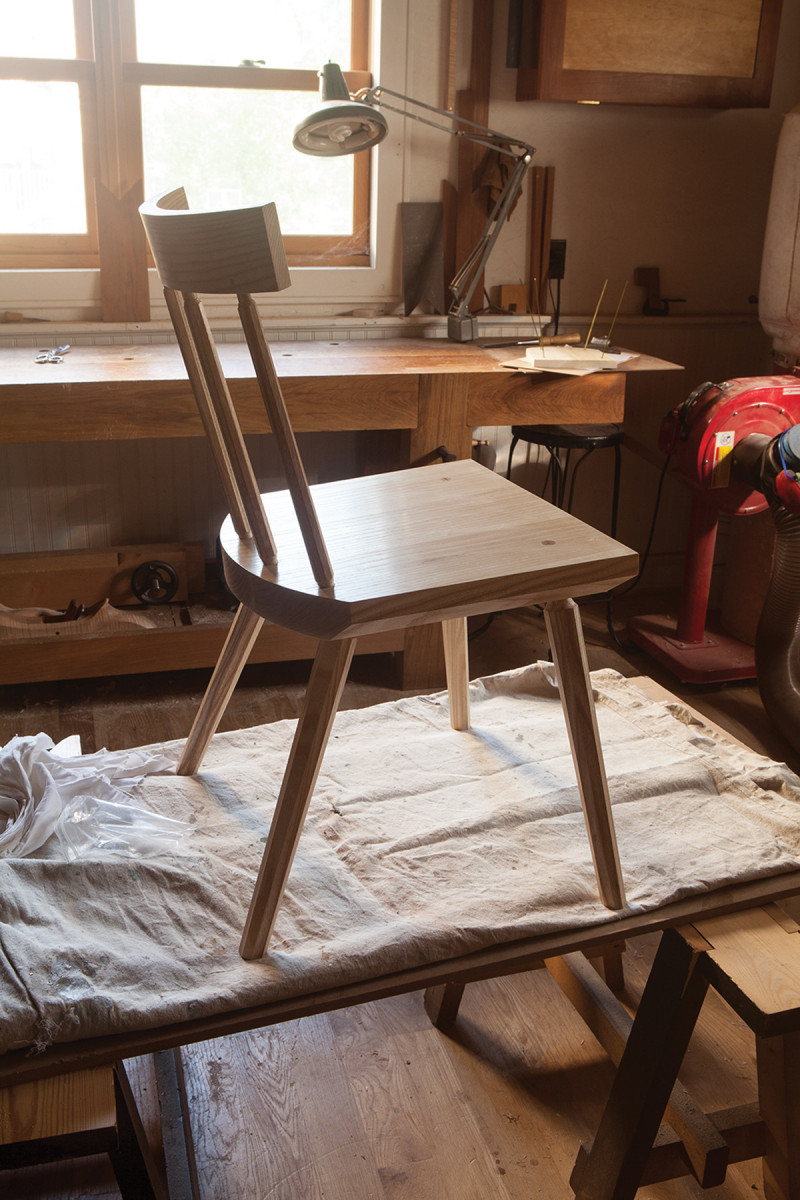
A soap shine. The waxy soap finish produces a medium sheen.
It’s a great finish, but it requires upkeep. If you are happy with the ease of melamine or the durability of bar top, you probably won’t like a soap finish.
What about the so-called ‘Scrubbed’ Finish?
Many dealers in vernacular antiques will describe a table as having a “scrubbed” finish on its top. Scrubbed tops are typically dead flat in sheen, nearly white and the subject of much controversy.
What made them look like this? Lye? Oxalic acid? A white pigment stain?
Chances are that a true scrubbed finish is created like this: You buy a table that has a finish – wax, oil, paint, whatever. It’s washed and scrubbed every day with household cleansers, bleach and a slightly abrasive pad. Over the course of decades, the original finish wears away and is replaced by cleanser and bleach.
Because this finish is desirable, antique dealers have a reputation for faking it by stripping off the top coat on a tabletop and bleaching out the wood’s color with oxalic acid or another kind of bleach.
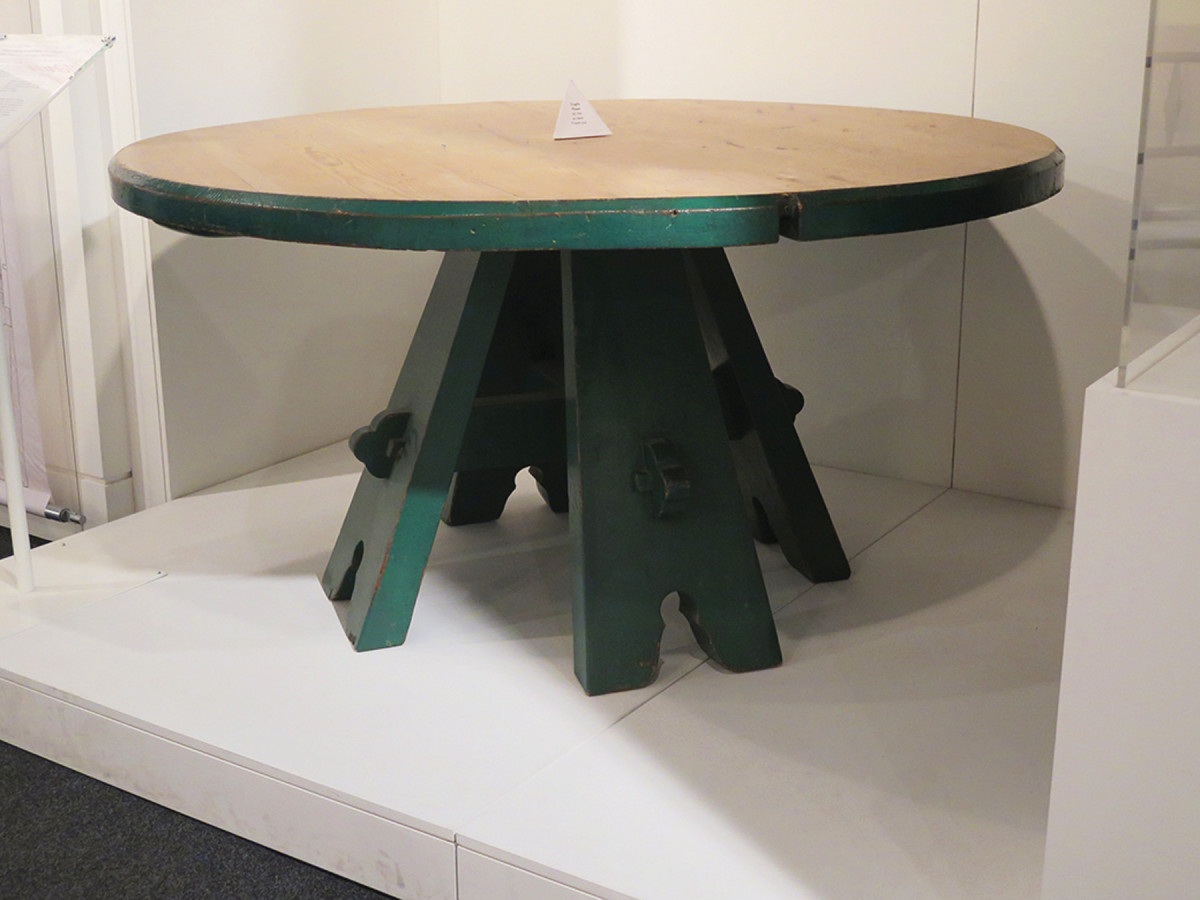
Scrubbed? Who knows if this 100-year-old tabletop is a true “scrubbed” finish. But this is what it’s supposed to look like.
Woodworkers can create a scrubbed finish by simply leaving off the topcoat and adding a soap finish. Then leave the rest to the client. The best description of a scrubbed finish is in Alan Peters’ book, “Cabinetmaking: The Professional Approach, 2nd edition” (Linden). As I cannot say it any better, here is a lengthy quote from that book about the topic:
“At times this (a flawless finish) disturbs me, for the surface that some admire and some craftsmen strive to satisfy has little to distinguish it from a piece of plastic laminate; for that is precisely what the surface has become, after the grain has been filled and endless coats of plastic film have been applied and painstakingly rubbed down.
“Natural wood finishes, such as oil and wax, are very susceptible to marking in their early stages and do require care and attention. Frankly, this dilemma of finding wood finishes that leave the material looking like wood, resist marking and improve rather than deteriorate with age, has dogged me and often defeated me these past 20 years….
“For example, a scrubbed finish to an oak dining table, so favoured by the Cotswold School, is a beautiful surface, immensely practical in use, improving with age and developing a wonderful surface texture that would look fine in many situations, especially in the older farmhouse or cottage-style dwelling, and for most of the time it requires no more than a wipe over with a damp cloth after a meal.
“However, it is also virtually colourless, just a bland uniform silvery grey. It has none of the colour variations of say a rosewood veneer or an oiled elm surface, and it is this richness of colour and grain that many of us find attractive about wood, so one has to move in this instance to a finish that heightens and preserves these characteristics….
“Ten years ago on moving to Devon I needed to make a pine kitchen/dining table quickly for our own use. Today, it is a beautiful golden colour similar to old stripped pine with not a bruise and hardly a scratch to be seen. We do not use a table cloth, only place mats, and we have never treated it at all gently. Yet, all that it has received in treatment or finish is a regular wipe over with a damp cloth after use and, once a month perhaps, it is thoroughly washed and scrubbed with hot water and household detergent. The hot water raises any bruises and scratches and the table looks like new, or rather, even better than new, for it has acquired a lovely patina now. There is no comparison with the treacly, bruised and scratched polyurethane surfaces so often encountered with modern manufactured pine tables.
“A scrubbed finish is not restricted to pine, and I have used it for dining and kitchen tables and sideboards in oak, chestnut, pine, cedar and also sycamore. In the case of the latter, if an occasional wash with household bleach is substituted for the detergent, a beautifully white spotless surface will result.
“My only regret is that I cannot persuade more of my customers to have this finish.”
I couldn’t agree more. My personal dining table was perfectly finished for about one day. Then my youngest daughter spilled fingernail polish remover (acetone) on it, cutting right through the lacquer and discoloring the wood.
During the next decade, the table saw many more injustices than that little spill. Now it looks like hell. The lacquer is crazed and lifted in places. Areas of the finish are down to bare wood.
I am on the verge of stripping off the lacquer on the tabletop and starting fresh, clean and naked. It seems a bit like revisionist history, like something Stalin would do if he were a woodworker. But I don’t envision this tabletop looking any better in my lifetime unless I remove the film finish and start over.
What Happens if…
Many people wonder if water, stains, heat or nasty solvents can hurt a soap finish. Yes, but the finish can be easily renewed with more soap. So don’t worry about it.
Can you use it over other finishes? Sure, but it’s best on raw wood. I’ve applied it over milk paint, cured oil, varnish and other finishes with varying results. If you aren’t sure (or don’t trust my advice) then try it on a sample board. You’ll get your answer.
No finish is perfect. But when it comes to a finish that is safe, easy to apply and easy to repair, soap is hard to beat.
Soap Finishes FAQ
Q: Will a finished object get foamy if wetted?
A: No. I have not found the finish to foam up under wet glasses or spills.
Q: Is it a food-safe finish?
A: While some people brush their teeth and clean fruit with Castile soap, I wouldn’t want to ingest it. It can irritate your skin and eyes, so why put it in your stomach? Stick with walnut oil or some other food-safe finish for spoons, etc.
Q: Does it go rancid?
A: I have not seen it go rancid, either in storage or on projects.
Q: How long does the soap mixture last once mixed?
A: Indefinitely in my experience. After several months the water and soap tend to separate, but the mixture is still usable.
Q: How often does it need to be applied?
A: The answer varies. A kitchen table might need monthly maintenance. A chair in an office might go for years without additional soaping.
Q: Can I use soap as a workbench finish?
A: Yup. I have found that it neither adds nor reduces friction. So it will provide a little more protection than leaving the top bare. It’s also a great place to experiment with a soap finish for the first time.
Q: When it gets wet, does the wood become slick?
A: No. It just feels like wet wood.
Here are some supplies and tools we find essential in our everyday work around the shop. We may receive a commission from sales referred by our links; however, we have carefully selected these products for their usefulness and quality.



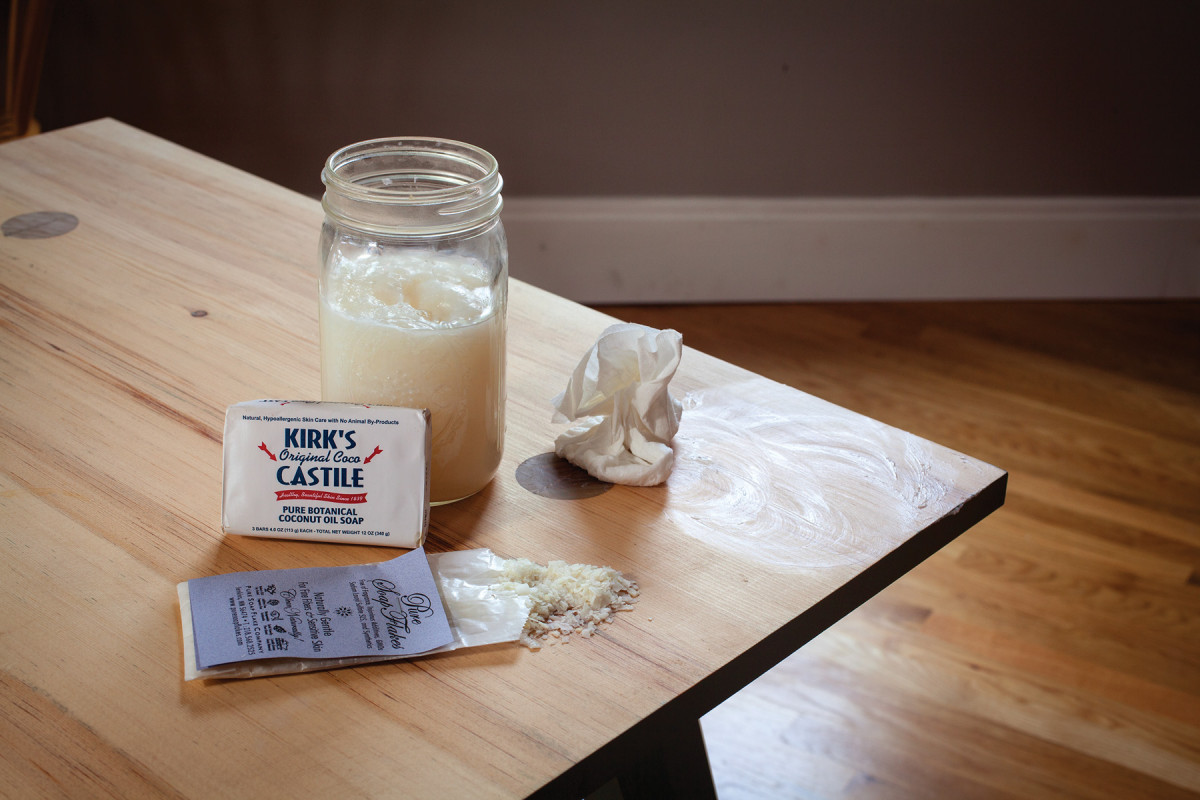 This traditional finish from Denmark is simple, safe and tactile.
This traditional finish from Denmark is simple, safe and tactile.




